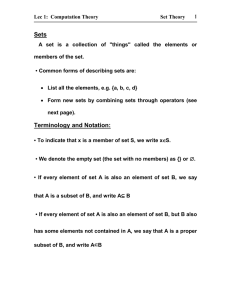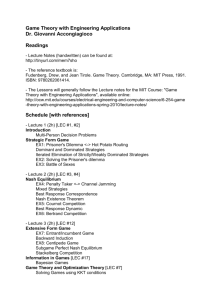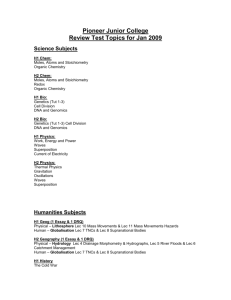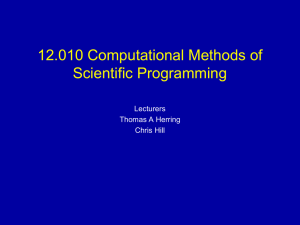Document 13567196
advertisement
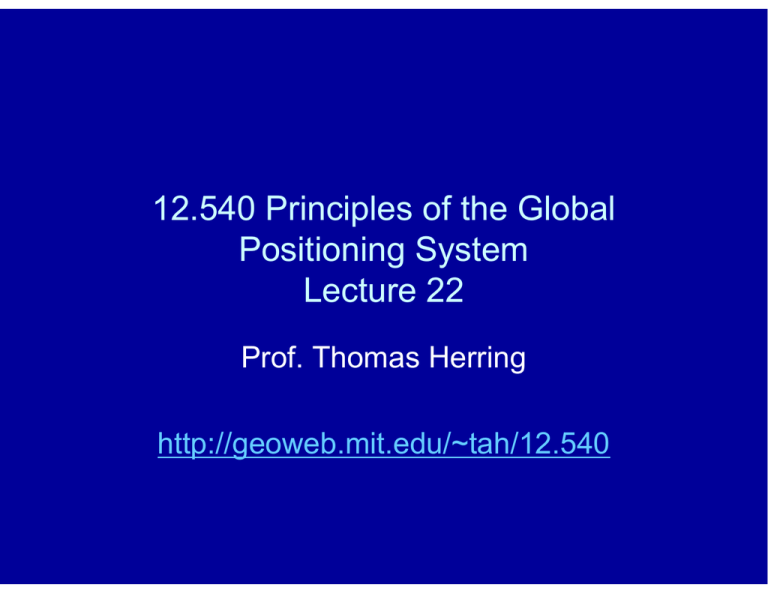
12.540 Principles of the Global Positioning System Lecture 22 Prof. Thomas Herring http://geoweb.mit.edu/~tah/12.540 Kinematic GPS • The style of GPS data collection and processing suggests that one or more GPS stations is moving (e.g., car, aircraft) • To obtain good results for positioning as a function of time requires that the ambiguities be fixed to integer values • Track is the MIT implementation of this style of processing 05/09/2012 12.540 Lec 22 2 Styles of kinematic GPS • Kinematic GPS techniques go by a number of names with features that are often receiver specific. – Kinematic GPS: Early term which implies that there is no loss of lock while the receiver is moving. In survey mode, if loss of lock occurs the antenna must be returned to a point of known location. – Rapid Static GPS: Technique that uses range and phase to resolve ambiguities. No need to maintain lock while receiver moving. Surveying where position during static portion all that is needed. – RTK Real-time kinematic: Kinematic solution with real-time radio telemetry link. Analysis is done on-the-fly. Very popular now with surveyors because results know instantly. 05/09/2012 12.540 Lec 22 3 General aspects • The success of kinematic processing depends on separation of sites • The MIT software allows multiple stations to be used in the positioning (may by kinematic or static) • For separations < 10 km, usually easy (most RTK systems work at these distances). • 10>100 km more difficult but often successful. Depends on quality of data and ionospheric activity. • >100 km very mixed results 05/09/2012 12.540 Lec 22 4 Issues with length • As site separation increases, the differential ionospheric delays increases, atmospheric delay differences also increase making modeling of phase data more difficult • For short baselines (<10 km), ionospheric delay can be treated as ~zero and L1 and L2 resolved separately • For longer baselines this is no longer true and ambiguities must be resolved with LC (and often the MW WL L1-L2 number of cycles) 05/09/2012 12.540 Lec 22 5 Track features • Track uses the Melbourne-Webena Wide Lane to resolve L1-L2 and then a combination of techniques to determine L1 and L2 cycles separately. • For short baselines uses a search technique and floating point estimation with L1 and L2 separately • For long baselines uses floating point estimate with LC and ionospheric delay constraint 05/09/2012 12.540 Lec 22 6 Ambiguity resolution • Basic problem is determine the integer number of cycles in the carrier phase double differences. • Two generic classes of approach: – Searching methods: Two basic types • Search over integer ambiguities checking RMS fit of phase residuals • Search over position, minimizing a fit function that does not depend on integer part of ambiguity (e.g.. Cosine of phase residuals) – Estimation and then resolution using statistical testing. 05/09/2012 12.540 Lec 22 7 Statistical Resolution • The most common method now is estimation with statistical assessment of fitting to integer. • Generic classes of cases: – NNNNN.01±0.01 Pretty clearly can be resolved – NNNNN.35±0.40 Highest probability answer is NNNNN but NNNNN+1 also has >10% of being correct. Since 10-100 ambiguities need to be resolved 1-10 of them would be incorrect in the above case. – NNNNN.01±0.55 clearly close to an integer but +1 value also very likely – NNNNN.35±0.01 should be resolvable to integer but value is far from integer, 05/09/2012 12.540 Lec 22 8 Statistical resolution • Uncertainties of ambiguities are always uncertain. Formal estimates come for inversion but these depend on data noise characteristics (most importantly correlations in data). • Many kinematic surveys done with high sampling rates (0.1-1Hz) so white noise assumptions generate very small error estimates. • Most testing methods use a “contrast” or “ratio” style test (ie., ratio of 2 with best and next best choice of ambiguities and an impact on 2 of setting the value to an integer. Covers last case shown--no integer seems correct implying modeling errors.) 05/09/2012 12.540 Lec 22 9 LAMBDA Method • In addition to individual values: Each ambiguity that is resolved, effects other estimates and thus there is a cascading effect. • The LAMBDA Method tries to account for these correlations by projecting the ambiguities into an orthogonal space. (Use of eigenvectors and eigenvalues discussed in earlier classes). • Method is from a linear operator that preserves integer values and transforms ambiguities so that estimates are nearly un-correlated. (Eigenvectors would make estimates uncorrelated, by integers would not be preserved). 05/09/2012 12.540 Lec 22 10 Magnitudes of effects of ambiguities • Basic changes in phase with ambiguities • Notice that N1=N2=1 (not detectable in the MW Widelane) cause a change of 0.56 cycles in LC and only 0.22 cycles in LG (variations in LG can be several cycles) • Combinations such as N1=3, N2=4 and N1=4 and N2=5 can cause small effects in LC (ie., geodetic fit looks good but ionospheric delay in error: if small can be detected but when large can be difficult). 05/09/2012 12.540 Lec 22 11 Cycle slip detection in kinematic processing • Detecting cycles slips can be difficult in kinematic processing because of vehicle movement. Normally in static GPS, coordinates are well enough known that changes on phase (LC combination) between epochs of data can be used. If a change is larger an a tolerance level (usually 0.2 to 0.5 cycles) then a cycle slip is detected. • Cycle slips are resolved to integers to fitting with simply polynomials across the epoch with the jump. • In kinematic processing this is much more difficult because the position of the moving receiver is not known. 05/09/2012 12.540 Lec 22 12 Cycle slips • Large jumps can be detected by using the pseudorange position estimate. In some cases,Doppler shift is also available and can be used. • Small slips (just a cycle or so can be difficult). M ore common than expected because the receivers try to fix cycle slips and they often get it wrong be a small amount (slips based in SNR). • MW WL and ionospheric delay jumps are common methods but can still leave slips un-detected. 05/09/2012 12.540 Lec 22 13 Basics of MIT track program • Track runs using a command file • The base inputs needed are: • Obs_file specifies names of rinex data files. Sites can be K kinematic or F fixed • Nav_file orbit file either broadcast ephemeris file or sp3 file • Mode air/short/long -- Mode command is not strictly needed but it sets defaults for variety of situations 05/09/2012 12.540 Lec 22 14 Basic Inputs for track. • Track runs using a command file • The base inputs needed are: – Obs_file specifies names of rinex data files. Sites can be K kinematic or F fixed – Nav_file orbit file either broadcast ephemeris file or sp3 file – Mode air/short/long -- Mode command is not strictly needed but it sets defaults for variety of situations – Normally back_type smooth would also be specified. • Normally start with just these commands and see how the run looks and based on this output start tuning track. 05/09/2012 12.540 Lec 22 15 Basic use • • • • Recommended to start with above commands and see how the solution looks Usage: track -f track.cmd >&! track.out Basic quality checks: egrep ‘^PRMS|TYPE’ on summary file or track out (RMS by PRN in mm) TYPE PRMS TYPE PRMS TYPE PRMS Site usn3 Site mitb Site rovr DT LC DT LC DT LC ALL 7.0 ALL 7.2 ALL 7.4 02 9.4 02 8.3 02 7.8 05 3.6 05 3.7 05 4.3 08 10.5 11.0 08 12.5 08 10 7.9 15 6.5 15 6.8 15 7.5 21 8.4 21 8.5 21 7.2 26 3.6 26 4.4 26 3.9 29 4.5 29 4.5 29 3.5 1.84 2.81 2.23 m, Apriori 0.95 1.46 1.11 m, Apriori • grep Kinematic track.out | head -<number of sites> TRACK Version 1.27 GPS Kinematic trajectory program Kinematic site usn3 appears static Coordinate coordinates good: Diff XYZ 0.74 -0.17 RMS m XYZ -0.25 Kinematic site mitb appears static Coordinate RMS XYZ coordinates good: Diff XYZ 1.70 m Kinematic site rovr appears0.93 dynamic -1.77Coordinate RMS XYZ 17.40 m. 17.84 18.26 • The message is repeated during the run (thus the head above) but the RMS position drops to 0.00 for non-kinematic sites. This is a pseudo range solution so RMS will be high. Make sure site behave the way you think they should. • Check track.sum file for ambiguity status and RMS scatter of residuals. 05/09/2012 12.540 Lec 22 16 Track command line % track -f <command file> -a <ambiguity file> -d <day> -w <week> -s <S01> <S02> .. <S10> where <command file> is a required file containing a list of commands to control the program (see below) <ambiguity file> is an optional file containing a modified set of integer bias parameters and settings (see full description below). <day> the string in this argument replaces <day> in the command file lines (e.g., bas1<day>0.03o will become bas12220.03o if the -d 222 option is given. <week> the string here will replace any <week> strings in the command file (useful for the nav_file name which could be a week of concatenated sp3 files. <S01>, <S02> .. <S10> are up to 10 strings that can be replaced in the command file i.e. the string <S01> in the command file will be replaced by the first string, <S02> by the second and so on. If one the strings is called space (all lower case), the corresponding <SXX> entry will be replaced by a blank character (This provides a means to un-comment lines) 05/09/2012 12.540 Lec 22 17 Basic use: Things to check • Check on number of ambiguities (biases) fixed – grep FINAL <summary file> • A 3 in column “Fixd” means fixed, 1 means still floating point estimate • If still non-fixed biases or atmospheric delays are estimated then smoothing solution should be made (back_type smooth) • output in NEU, geodetic, DHU, XYZ coordinates. NEU are simple North East distances and height differences from fixed site. (Convenient for plotting and small position changes). DHU is similar but difference are from the apriori coordinates of the site. 05/09/2012 12.540 Lec 22 18 More advanced features • Track has a large help file which explains strategies for using the program, commands available and an explanation of the output and how to interpret it. • It is possible to read a set of ambiguities in. – Works by running track and extracting FINAL lines into an ambiguity file. Setting 7 for the Fixd column will force fix the ambiguity. ambiguity file is then read into track (-a option or ambin_file) 05/09/2012 12.540 Lec 22 19 Advanced features • Commands allow control of how the biases are fixed and editing criteria for data • Editing is tricky because on moving platform, jumps in phase could simply be movement • Ion delay and MW WL used for editing. • Explicit edit_svs command allows removal of problematic data 05/09/2012 12.540 Lec 22 20 Some results • Solutions with LC and with L1+L2 (less noise but larger ionospheric delay. • Output of processing in track_LC.out • Solutions in North, East Up differential position from roof pg ERL: track.NEU.rovr.LC and track.NEU.rovr.L1+L2 05/09/2012 12.540 Lec 22 21 East Evolution 05/09/2012 12.540 Lec 22 22 Zoom of features 05/09/2012 12.540 Lec 22 23 East versus North Plot 05/09/2012 12.540 Lec 22 24 Zoom 05/09/2012 12.540 Lec 22 25 2010 Results 40 N P1+P2 N LC N L1+L2 20 Results shown for pseudorange (P1+P2) and phase (L1+L2 and LC) North (m) 0 ‐20 Distances from base station. ‐40 ‐60 ‐40 05/09/2012 ‐20 0 East (m) 20 12.540 Lec 22 40 26 ‐40 MIT zoom with range and phase results N P1+P2 N LC N L1+L2 North (m) ‐45 ‐50 ‐55 05/09/2012 ‐25 ‐20 East (m) ‐15 12.540 Lec 22 27 Just phase results ‐40 N P1+P2 N LC N L1+L2 North (m) ‐45 ‐50 ‐55 ‐25 05/09/2012 ‐20 East (m) ‐15 12.540 Lec 22 28 Height results 2 Height (m) 1 0 ‐1 ‐2 H P1+P2 H LC H L1+L2 ‐3 ‐4 0 05/09/2012 200 400 600 Epoch 800 12.540 Lec 22 1000 1200 1400 29 Summary • Track is still developmental and performance depends on quality of GPS data • For short baselines it usually works well, for longer baselines it can be difficult • There are frequent updates to the program 05/09/2012 12.540 Lec 22 30 MIT OpenCourseWare http://ocw.mit.edu 12.540 Principles of the Global Positioning System Spring 2012 For information about citing these materials or our Terms of Use, visit: http://ocw.mit.edu/terms.
